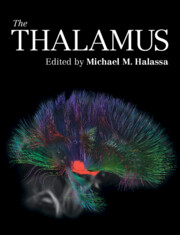Book contents
- The Thalamus
- The Thalamus
- Copyright page
- Contents
- Contributors
- Preface
- Section 1: History
- Section 2: Anatomy
- Section 3: Evolution
- Section 4: Development
- Section 5: Sensory Processing
- Section 6: Motor Control
- Chapter 14 Motor Thalamic Interactions with the Brainstem and Basal Ganglia
- Chapter 15 Cerebellar Regulation of the Thalamus
- Section 7: Cognition
- Section 8: Arousal
- Section 9: Computation
- Index
- References
Chapter 14 - Motor Thalamic Interactions with the Brainstem and Basal Ganglia
from Section 6: - Motor Control
Published online by Cambridge University Press: 12 August 2022
- The Thalamus
- The Thalamus
- Copyright page
- Contents
- Contributors
- Preface
- Section 1: History
- Section 2: Anatomy
- Section 3: Evolution
- Section 4: Development
- Section 5: Sensory Processing
- Section 6: Motor Control
- Chapter 14 Motor Thalamic Interactions with the Brainstem and Basal Ganglia
- Chapter 15 Cerebellar Regulation of the Thalamus
- Section 7: Cognition
- Section 8: Arousal
- Section 9: Computation
- Index
- References
Summary
The motor thalamus is interconnected with the brainstem, cortex, and basal ganglia and plays major roles in planning, sequencing, and executing action. In this chapter, I highlight roles of input-defined thalamic circuits in motor sequence production and learning. Brainstem–motor thalamic pathways carry efference copy signals important for the production of both innate and learned motor sequences, for example, during saccades, grooming, and birdsong. Basal ganglia thalamocortical loops implement aspects of reinforcement learning, including the generation of motor exploration during vocal babbling. Classic "gating" models of basal ganglia–thalamic transmission fail to explain thalamic discharge during behavior, which instead appears strongly driven by cortical inputs. A challenge going forward is to determine if there are conserved principles of thalamic function across diverse motor thalamic subregions.
- Type
- Chapter
- Information
- The Thalamus , pp. 269 - 283Publisher: Cambridge University PressPrint publication year: 2022



